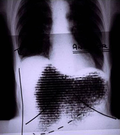Rectilinear scanner
Rectilinear scanner is a type of medical imaging device used in nuclear medicine to capture images of the body's internal structures. It is a predecessor to the modern gamma camera and is used less frequently in contemporary medical practice.
Overview[edit]
The rectilinear scanner works by detecting radioactive substances that have been introduced into the patient's body. The scanner moves in a straight line (or 'rectilinear' pattern) across the body, picking up the gamma rays emitted by the radioactive substance. This information is then used to create an image of the area being scanned.
History[edit]
The rectilinear scanner was developed in the 1950s and was one of the first imaging devices used in nuclear medicine. It was a significant improvement over previous methods, which involved manually moving a detector over the patient's body.
Operation[edit]
The operation of a rectilinear scanner involves the administration of a radiopharmaceutical to the patient. This substance travels through the body and accumulates in the area to be scanned. The scanner then moves across the body, detecting the gamma rays emitted by the radiopharmaceutical. The intensity of the detected radiation is used to create an image of the internal structure.
Limitations[edit]
While the rectilinear scanner was a significant advancement in medical imaging, it has several limitations. The images produced are two-dimensional and lack the detail of more modern imaging techniques. Additionally, the scanner can only image a small area at a time, making it less suitable for scanning large areas of the body.
See also[edit]
Ad. Transform your life with W8MD's Budget GLP-1 injections from $75


W8MD offers a medical weight loss program to lose weight in Philadelphia. Our physician-supervised medical weight loss provides:
- Weight loss injections in NYC (generic and brand names):
- Zepbound / Mounjaro, Wegovy / Ozempic, Saxenda
- Most insurances accepted or discounted self-pay rates. We will obtain insurance prior authorizations if needed.
- Generic GLP1 weight loss injections from $75 for the starting dose.
- Also offer prescription weight loss medications including Phentermine, Qsymia, Diethylpropion, Contrave etc.
NYC weight loss doctor appointmentsNYC weight loss doctor appointments
Start your NYC weight loss journey today at our NYC medical weight loss and Philadelphia medical weight loss clinics.
- Call 718-946-5500 to lose weight in NYC or for medical weight loss in Philadelphia 215-676-2334.
- Tags:NYC medical weight loss, Philadelphia lose weight Zepbound NYC, Budget GLP1 weight loss injections, Wegovy Philadelphia, Wegovy NYC, Philadelphia medical weight loss, Brookly weight loss and Wegovy NYC
|
WikiMD's Wellness Encyclopedia |
| Let Food Be Thy Medicine Medicine Thy Food - Hippocrates |
Medical Disclaimer: WikiMD is not a substitute for professional medical advice. The information on WikiMD is provided as an information resource only, may be incorrect, outdated or misleading, and is not to be used or relied on for any diagnostic or treatment purposes. Please consult your health care provider before making any healthcare decisions or for guidance about a specific medical condition. WikiMD expressly disclaims responsibility, and shall have no liability, for any damages, loss, injury, or liability whatsoever suffered as a result of your reliance on the information contained in this site. By visiting this site you agree to the foregoing terms and conditions, which may from time to time be changed or supplemented by WikiMD. If you do not agree to the foregoing terms and conditions, you should not enter or use this site. See full disclaimer.
Credits:Most images are courtesy of Wikimedia commons, and templates, categories Wikipedia, licensed under CC BY SA or similar.
Translate this page: - East Asian
中文,
日本,
한국어,
South Asian
हिन्दी,
தமிழ்,
తెలుగు,
Urdu,
ಕನ್ನಡ,
Southeast Asian
Indonesian,
Vietnamese,
Thai,
မြန်မာဘာသာ,
বাংলা
European
español,
Deutsch,
français,
Greek,
português do Brasil,
polski,
română,
русский,
Nederlands,
norsk,
svenska,
suomi,
Italian
Middle Eastern & African
عربى,
Turkish,
Persian,
Hebrew,
Afrikaans,
isiZulu,
Kiswahili,
Other
Bulgarian,
Hungarian,
Czech,
Swedish,
മലയാളം,
मराठी,
ਪੰਜਾਬੀ,
ગુજરાતી,
Portuguese,
Ukrainian



